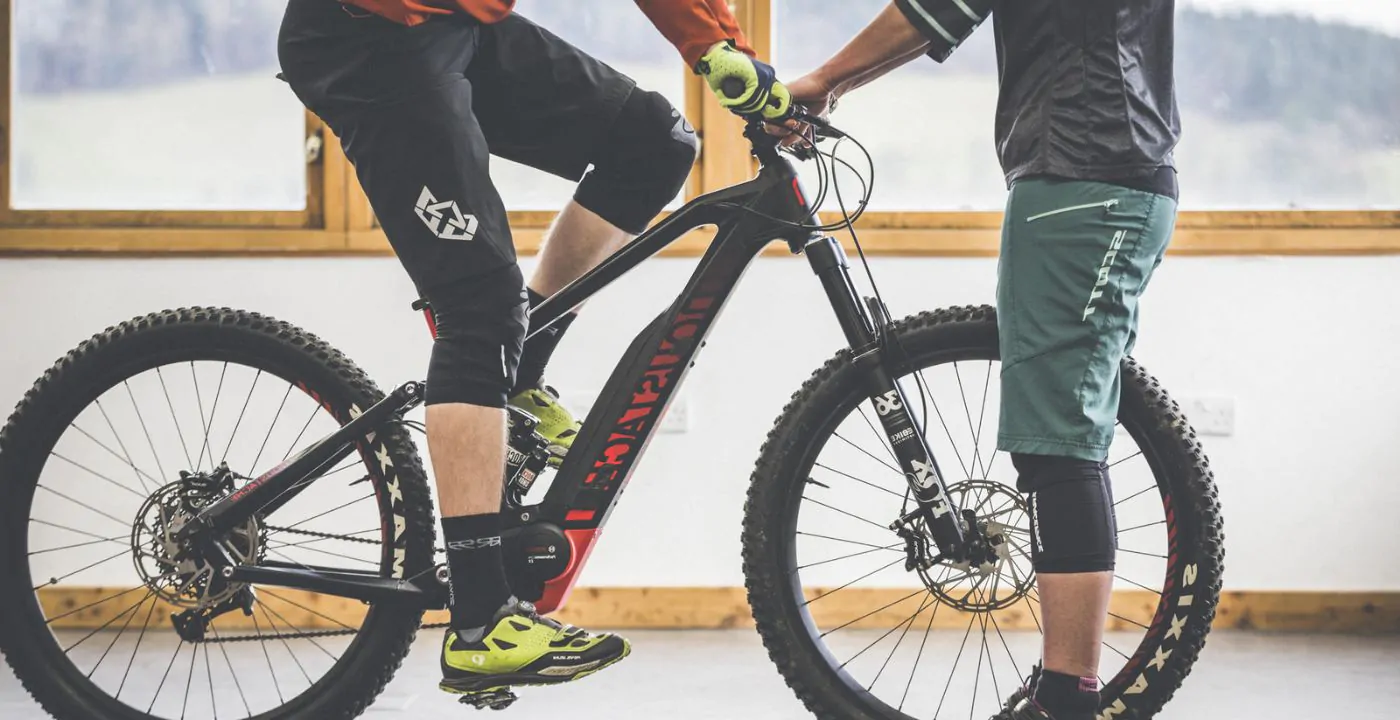
With so many e-bikes on the market it’s often hard to figure out what size to get. E-bike size should be one of your most important considerations when researching which electric mountain bike is right for you.
There are pitfalls if you don’t get the size right, your e-bike could be too big or you could end up with it being too small – making riding an expensive and uncomfortable nightmare.
So how should you size an e-mountain bike?
Which electric mountain bike frame size you get and how tall the e-bike is, are both important factors to take into account, to make sure you’re well prepared to hit the trails and country paths.
Using an online size chart is one useful tool to begin the process for both men’s and women’s e-mountain bikes.
ebike Size Chart

| Height | Inside leg | Mountain E-bike frame size |
|---|---|---|
| 147cm-152cm / 4'10”-5'0″ | 66cm / 26″ | 13″ (X Small) |
| 152cm-160cm / 5'0″-5'3″ | 69cm / 27″ | 13″, 14″ (X Small) |
| 160cm-170cm / 5'3″-5'7″ | 71cm / 28″ | 15″, 16″ (Small) |
| 170cm-175cm / 5'7″-5'9″ | 76cm / 30″ | 17″, 18″ (Medium) |
| 175cm-180cm / 5'9″-5'11” | 79cm / 31″ | 18″, 19″ (Medium, Large) |
| 180cm-188cm / 5'11”-6'2″ | 81cm / 32″ | 19″, 20″ (Large) |
| 188cm-196cm / 6'2″-6'5″ | 86cm / 34″ | 20″, 21″, 22″ (Large, X Large) |
| 196cm+ / 6′ 5″+ | 91cm / 36″ | 23″, 24″ (XX Large) |
Frame size
Numbers on a chart can be useful, but really what does it all mean?
Stand over height is hugely important – this essentially boils down to how close your bits and bobs down below are from the bike’s top tube – while also factoring in how close your saddle is to the handlebar.
Comfort is key and if you’re going out for a long e-mountain bike ride, the last thing you want is to be hunched over, reaching too far for your handle bars or bashing your nether regions about for a few hours.
So – finding the maximum stand over height is key and this will ensure you get the right e-mountain bike frame size.

Saddle height

If you want to make sure your feet touch the floor, getting the right saddle height is hugely important. If not, you could find yourself dangling in the air like a small child sitting in an adult’s chair at the dinner table.
The right saddle height ensures you get the maximum power output and ensures your legs are rotating in a comfortable position.
This is important, not just so you’re able to touch the floor, but also because you could end up overstraining or over-stretching your muscles if your saddle is too high, or put too much pressure on your joints if you’re sitting too low in the saddle.
Fortunately, most e-mountain bike manufacturers have this covered and include an adjustable saddle, which you can raise and lower to the needs of your body.
Should my feet touch the floor on my e-bike?
It’s hugely important for at least one foot to be able to touch the ground on all e-bikes and e-mountain bikes.
This allows you to balance when stationary or begin your pedal stroke comfortably. If you can't, there is a chance you could just topple over, which is never going to look particularly cool on your brand new e-bike or e-MTB.
It also helps reduce your chances of a crash if you have to take evasive action and get a foot down quickly to stop yourself.
You can get the right height for you by adjusting the height of the seat.
Handlebar size

Whereas the seat height is important for your power output and comfort on your e-MTB, the handlebar positioning and size is key for control.
Like with the seat, many manufacturers include easily adjustable handlebars, so you can lower or heighten them to your needs.
If you have the handlebars too low you could find yourself over stretching and, particularly on long rides, putting a lot of pressure on your neck and shoulders.
The saddle height and handlebar height should be factored in together as one – if not, you could find one being perfect and the other still being out of align, making for an uncomfortable ride.
In most cases – the handlebars and saddle height should be within 5cm of each other. Although, of course, there are sometimes exceptions.
For the more experienced rider the width of the handlebars is sometimes factored in, with shorter handlebars making it easier to negotiate through tight trails, but for the novice, this is less of a consideration and can be shortened at a bike shop at a later date.

What is mountain bike RAD?
RAD stands for – rider area distance – which is the distance between your e-MTB handlebar grips and your pedals.
It’s important to get this nailed on because it allows you to have maximum arm range for breaking, cornering and descending, while also allowing perfect placement for you to generate power with your legs.
How do you measure e-MTB RAD?
World renowned MTB skills author and instructor, Lee McCormack, suggested in his booked “Dialled” the best way to measure RAD is:
“A rider can measure the RAD of their bicycle by running a string from the top of one grip to the other to create a horizontal line, then measuring from the bottom bracket parallel with the frame to a centerpoint 1 centimeter below the string on the bars.”
This is seen as the best way in the industry to get your RAD angle spot on.
What else is important?
Women's e-bike mountain bike size guide
There are specific women e-mountain bikes on the market, but women above an average height should also consider looking at the men’s e-MTB range, as the women’s ranges are often built smaller and you might not always find the right e-mountain bike frame size you need.
Different brand sizes
It’s also worth shopping about. Different e-MTB manufacturers don’t all use the same size guide or dimensions, so if one brand isn’t right for you, it’s a good idea to explore some of the other brands. They may make their bikes slightly bigger or smaller – this is really important if you’re particularly tall or a shorter man or woman.
How do I know if my e-mountain bike is too big?
If your e-bike or e-MTB is too big you will soon find out. Even a short ride will become a struggle and you certainly won’t be gliding through the trees and trails.
What to watch out for:
- Strains and pains – if your e-MTB is too big you’ll soon find yourself aching in areas you weren’t before, particularly your neck, shoulders and knees. Too long a frame or tall a saddle will make you reach for the handlebars and struggle to get to the pedals – as a result you’ll put all sorts of pressure on your muscles and joints.
- Turning and cornering struggles – if you’re hitting the trails and feel like you’re wrestling a wild beast around the corners, then your e-MTB is too big for you. You should be in control, not the e-bike.
- Heavy-lifting – if you are struggling to pop your front wheel up over small obstacles, after a bit of practice – such as a kerb – then your e-bike is likely to be too big and heavy for you. It shouldn’t feel like lifting the front of a sofa, it should again be a fairly easy task. Again – you should be in control.
Final Thoughts
Using an e-MTB bike size guide chart, like the one in our blog, is a good starting point to get you going and a useful way to have a rough idea of the e-bike size you’ll need – then take into account things like e-mountain bike frame size, standover height, saddle height and handlebar size.
Making sure at least one foot touches the floor while stationary on your e-mountain bike is really important to help you balance at junctions, put a foot down in an emergency and reduce the chance of crashes. It’s also important to focus on your rider area distance (RAD) – which gives you maximum arm range for cornering, breaking, descending and balancing in general.



